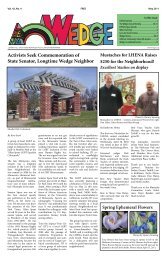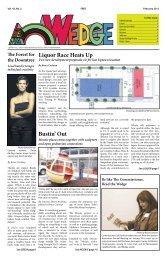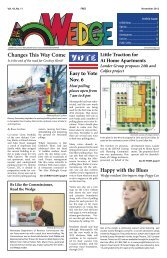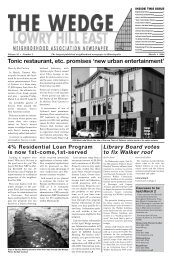28th-Annual Palio More Than Just a Neighborhood Gathering
Sep 2010 - Lowry Hill East Neighborhood Association
Sep 2010 - Lowry Hill East Neighborhood Association
Create successful ePaper yourself
Turn your PDF publications into a flip-book with our unique Google optimized e-Paper software.
SEPTEMBER, 2010<br />
THE WEDGE VOL. 41, NO. 9<br />
Miss Sterrett’s School—A Wedge History of Strong Women and Their Drive to Educate (Part 1)<br />
Editor’s Note: This is the first<br />
installment of an edited history of<br />
Miss Sterrett’s School and Miss<br />
Wood’s Kindergarten-Primary<br />
Training School, formerly located at<br />
2017 Bryant Avenue South, Lowry<br />
Hill East. The remainder of the series<br />
will appear in future issues of the<br />
Wedge.<br />
❐ WEDGE HISTORY<br />
BY KATHLEEN KULLBERG<br />
Children’s education has always been<br />
one of the top local priorities,<br />
beginning with the early founders of<br />
the new communities of St. Anthony<br />
and Minneapolis. In the early dawn of<br />
the village of St. Anthony in 1848,<br />
the small body of residents gladly<br />
accepted the offer of the Ard Godfrey<br />
home as an occasional site for school<br />
lessons until a suitable building could<br />
be erected. As the population rapidly<br />
increased, so did the urgency to<br />
provide schools for its youngsters.<br />
When industry and the<br />
population expanded across the<br />
Mississippi after 1851, it was only<br />
logical that schools should follow suit<br />
—though most were built on the near<br />
north and St. Anthony side of the<br />
river, until more permanent bridges<br />
could be built for accessibility. Mass<br />
transportation was still a major<br />
obstacle, and most children had to<br />
walk to school. Children under five<br />
years stayed at home, because there<br />
was no curriculum for the very<br />
young.<br />
Rapid growth and expansion on the<br />
west side of the river soon followed<br />
the advent of the rapid transit<br />
streetcar network, with families<br />
moving farther out into new<br />
developments such as Kenwood and<br />
Lowry Hill, and to the farms along<br />
the southern edge of Hennepin<br />
County. By 1872, the southern<br />
boundary of the City was Franklin<br />
Avenue—and it was vital to provide<br />
schools for this burgeoning<br />
community.<br />
Still, at this time there was no<br />
provision for educating the very<br />
young—under five years old—until a<br />
small group of public-spirited citizens<br />
organized the Minneapolis<br />
Kindergarten Association in April of<br />
1892. Its main objective was to<br />
promote and make the new European<br />
concept of kindergartens part of the<br />
public school system so that every<br />
child could have the benefit of early<br />
childhood education.<br />
The first meeting of those<br />
concerned citizens, among them Mrs.<br />
Jacob. H. Cook and Mrs. Charles W.<br />
Keyes, was so enthusiastic that,<br />
before adjourning, organizational<br />
plans and the goal of encouraging<br />
public support were developed. At<br />
that first large meeting at Plymouth<br />
Church on April 22, 1892, Judge<br />
Robert D. Russell offered a resolution<br />
in support of establishing public<br />
kindergartens. Dr. Marion D. Shutter<br />
was made permanent chairman of the<br />
new Minneapolis Kindergarten<br />
Association.<br />
The general public forwarded the<br />
idea and donated large contributions,<br />
and the first Association kindergarten<br />
was opened in St. Mark's Episcopal<br />
Church downtown. Mrs. Elsie Payne<br />
Adams of Chicago was hired as the<br />
first superintendent and supervisor in<br />
charge of both the training classes in<br />
the normal school and the<br />
kindergartens. However, a<br />
specialized program for training<br />
teachers only for kindergarten was in<br />
its early infancy.<br />
In 1896, a fortunate turn of<br />
events elected Stella Louise Wood of<br />
Chicago to replace Jean MacArthur,<br />
who had begun a teacher training<br />
school in Gethsemane Church.<br />
Kindergarten teachers never had a<br />
targeted curriculum until the advent<br />
of the training school at this time.<br />
This first school had 15 student<br />
teachers in all: 10 seniors and five<br />
juniors. By the first annual meeting of<br />
the Association, five kindergartens<br />
had been supported (though not<br />
located in public schools). Among<br />
those early citizens was Mrs. Thomas<br />
Lowry, who tirelessly donated her<br />
time to raise money for the program.<br />
The teacher training school<br />
moved several times downtown from<br />
church to church, and even shared<br />
space at the YWCA for physical<br />
PAGE 7<br />
education classes, and with the<br />
Handicraft Guild on Tenth Street for<br />
art classes. Finally, in 1913, most<br />
classes were held at Wells Memorial<br />
Settlement House on Eleventh<br />
Street. By 1905, the name of the<br />
school permanently changed to Miss<br />
Wood’s Kindergarten-Primary<br />
Training School, and focused solely<br />
on graduating competent<br />
kindergarten-through-third-grade<br />
teachers.<br />
Miss Sterrett’s School History<br />
The first kindergarten in connection<br />
with St. Paul’s Episcopal Church was<br />
established in the early days of the<br />
1880s, when the church was located<br />
on Hennepin and 12 th . In 1901, St.<br />
Paul’s was physically cut into three<br />
sections and moved up the hill by<br />
horse drawn vehicles to its new<br />
location at the corner of West<br />
Franklin and Bryant Avenues. There it<br />
stood until demolished in 1965 and<br />
replaced by the current Tower<br />
Apartments.<br />
Because of the economic<br />
conditions of the day, the burgeoning<br />
interest in primary schools, and the<br />
lack of suitable facilities in Lowry<br />
Hill East, St. Paul’s Vestry in 1910<br />
was advised to carry on teaching<br />
some of the children beyond<br />
kindergarten age—and so a primary<br />
school was established under the<br />
direction of Miss Margaret Sterrett, a<br />
former teacher at Peabody Public<br />
School and a member of the parish.<br />
This school met in the main room of<br />
the Parish House located at 2012<br />
Aldrich, but it soon grew to such<br />
proportions that Sterrett decided to<br />
move. ❍ TO BE CONTINUED<br />
Stella Wood<br />
Walker Library Update<br />
From Hennepin County Commissioner,<br />
3rd District, Gail Dorfman<br />
The Request For Proposals was issued last month and<br />
essentially represented the vision and guidelines<br />
established by the Walker Community Advisory<br />
Committee (CAC). 21 architecture firms responded with<br />
proposals. Most were local, but a couple were out-of-state<br />
firms partnering with local ones.<br />
The Hennepin County Designer Selection<br />
Committee is in the process of scheduling in-person<br />
interviews with firms to review proposals. They’ve<br />
narrowed it down to five to ten firms. After the interviews,<br />
they’ll select two or three to recommend to the County<br />
Board. The Board will probably consider the<br />
recommendations in late August or early September. Once<br />
a firm is selected, that firm will begin working with the<br />
Community Advisory Committee as they get into the<br />
details of design. I think there’s an opportunity, if<br />
neighborhoods are interested, to expand participation in<br />
the CAC. The CAC will also be advising the design firm<br />
on ways to engage more members of the public. I’m<br />
interested in enhancing public outreach over the next year<br />
to make sure the library meets the community vision and<br />
includes public space, programming, collection materials,<br />
etc. that meet community needs.<br />
For more information go to www.hclib.org/cac or<br />
contact Commissioner Dorfman at 612.348.7883 or<br />
Gail.Dorfman@co.hennepin.mn.us.❍<br />
<br />
<br />
At any one of our neighborhood clinics, you’ll find a full<br />
range of primary and specialty care services, ready<br />
when you need them most. From pregnancy care to<br />
physical exams to senior care, your family has a home for<br />
healthcare – right in the neighborhood.<br />
Call 612-873-3300 for same<br />
or next day appointments.<br />
www.hcmc.org/clinics<br />
<strong>Neighborhood</strong> Clinics<br />
BROOKLYN CENTER | BLOOMINGTON | RICHFIELD | SOUTH MINNEAPOLIS | EAST LAKE







